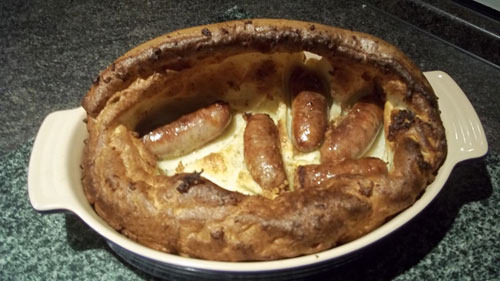Delightful British Foods With Strange Names
In Mark Damon Puckett's continuing quest to explain British food — he has already tackled the Scotch egg and the Cornish Pasty — Puckett tackles a trio of oddly-named British foods that are actually delightful.
Toad in the Hole? Bubble and Squeak? Spotted Dick?
Such linguistic playfulness might have you wondering and smirking when perusing the menu at pubs and restaurants throughout England, but these are relatively simple English dishes that have highly risible names. When I asked my English and South African friends to make them in London, they complied not just with cooking alacrity but with photos and recipes as well. These are not meals normally seen in American kitchens and require a bit of English touch in explaining what they are, so below is a brief talking-around-the-kitchen history of all three and tips on how to make them:
Toad in the Hole
Toad in the Hole, well, you have to see it to visualize it because it resembles just that: an aberrant toad ensconced in a hole. This dish came about from using leftover meat baked in the oven in a Yorkshire pudding batter — to create a meal in leaner times. Sausages have replaced the leftovers, though, and you can now use any type of sausage you want. It's best served with an onion gravy, potato, cabbage, and carrots.
"I like the simplicity of English home comfort food," says chef Bruce Venter, chef de cuisine for Royal Caribbean. "I look forward to lovely London pork sausages in a light crispy Yorkshire pudding, soaked in homemade onion gravy, absorbing all the flavors of the brown onion and beef drippings. It's filling, tasty, and sucks up the gravy."
Toad in the hole. Photo credit: Matthew Haynes
Bubble and Squeak
Bubble and Squeak is a modern take on traditional, leftover "veg" from Sunday roast that would often end up being a Monday meal. You might think of this as an English hash brown of sorts. It is made from leftover roast potatoes and vegetables from the Sunday roast, which is why there is no set recipe for the dish, although cabbage or Brussels sprouts should be part of the vegetables used.
Up until World War II, Bubble and Squeak was made with beef trimmings and cabbage (no potatoes), and it came about from the onomatopoeic sound that cabbage sound made when frying. But then beef was taken out due to rationing, and only potatoes and vegetables were used. The main idea with Bubble and Squeak is to not waste any food and use all the leftovers.
With no real recipe per se, to make this dish vegetables are roughly chopped and mixed together and then pan-fried with an onion. The potato is coarsely mashed and then mixed together with the vegetables. It is very important that the ratio of vegetable and potato in the mix is 1:1, or half potato and half vegetables (onion, cabbage, Brussels sprouts, peas). Once this is done, make as many small patties (about the size of beef burgers) as you can out of the combined mixture; they are then dusted with flour and pan-fried until golden brown.
Bubble and Squeak can either be eaten on its own or with bacon and eggs, with gammon steak and a poached egg, or with smoked salmon, hollandaise, Sevruga caviar... or anything else you like. Really, it's down to personal preference.
Bubble and squeak. Photo credit: Matthew Haynes
Spotted Dick
Spotted Dick is a winter, steamed beef suet pudding made with currants (or raisins) and is a staple of public boys' schools in England. It's traditionally rolled and, once cooked, cut into slices and served with custard.
It's an easy dish to make on a large scale and it very filling, and it can be seen a lot around Christmas. The currants give it the "spots"; where the dick came from is up for some etymological debate.
Spotted Dick Photo credit: Matthew Haynes
Mark Damon Puckett has written for Saveur and Greenwich Magazine. He is the author of The Reclusives, YOU with The Ill-usives, and The Killer Detective Novelist (October 2012), all available on amazon.com and bn.com. Please visit him at www.markdamonpuckett.com.
Chef Bruce Venter and Matthew Haynes contributed to the content of this article, wrote the recipes, cooked the dishes to photograph, and took the accompanying photos. Venter is South African and incorporates his love for international travel and food by working for Royal Caribbean as one of their Chef de Cuisines, traveling the globe cooking. He has worked in many top hotels and restaurants on two continents and has cooked for royalty, stars, and heads of state.
Matthew Haynes lives in London, is a friend and patron to writers, and takes a mean Toad in the Hole photo.

